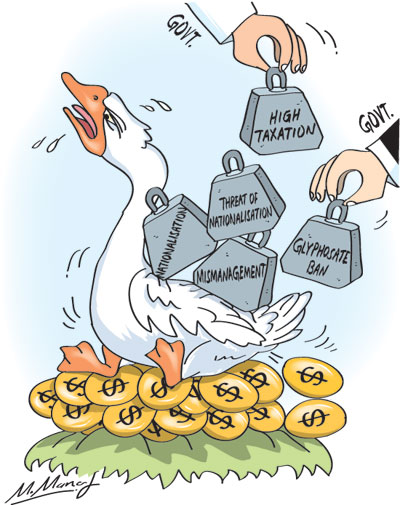Columns
Killing the goose that lays the golden eggs: Neglecting the country’s highest export earner
View(s):Tea has been Sri Lanka’s highest export earner from the latter part of the nineteenth century and is still the country’s highest domestic value added export earner.
 Despite the paramount importance of tea for the economy, the seventy post independent years have been characterized by a neglect of the tea industry. Over the past seven decades the country has lost her preeminent position in global tea production and exports, though it remains among the highest producers and exporters of tea. A new resolve to enhance productivity and increase production of tea to increase exports could be of immense benefit to the economy.
Despite the paramount importance of tea for the economy, the seventy post independent years have been characterized by a neglect of the tea industry. Over the past seven decades the country has lost her preeminent position in global tea production and exports, though it remains among the highest producers and exporters of tea. A new resolve to enhance productivity and increase production of tea to increase exports could be of immense benefit to the economy.
Neglect
High taxation in the past, threats of nationalization, nationalization of tea plantations, mismanagement of state owned plantations and the underfunding of the Tea Research Institute have hampered the tea plantations. The latest blunder was the banning of glyphosate imports that is an essential weedicide in 2015 without a scientific basis.
 Achievement
Achievement
The bright spot in tea has been the development of smallholdings tea cultivation that now accounts for nearly 70 percent of the country’s tea production. The productivity on tea smallholdings is much higher than on the estates.
Sudden interest
There was a new focus on tea exports when someone put in a beetle into a shipment of tea to Russia. Whoever may have put in a beetle or whether a beetle was in fact found will remain a mystery. Russia threatened or perhaps stopped imports of Sri Lankan tea till we agreed to import Russian asbestos. We reversed our decision on asbestos imports and Russia resumed imports of tea from Sri Lanka!!
Even exports of tea to a single country was seen as a significant blow to the economy and the government acted promptly to ensure exports to Russia. The sudden interest evoked by this episode had the unintended benefit of focusing on the economic importance of tea exports. This threat of a loss of a single country market brought out the significance of tea exports.
If exports to Russia that accounts for 26 percent of the country’s tea exports is significant then total tea exports must matter more.
Lesser significance
There has been a lesser focus on the tea industry after the diversification of exports from the 1980s as export statistics show that tea accounts for only about 25 percent of exports, while industrial exports contribute about 70 percent of total exports. Garments, which is the main manufactured export, accounts for nearly 50 percent of manufactured exports. These statistics have tended to give tea a lesser significance.
Importance
However these statistics are deceptive and distort the importance of the tea industry. Tea production has a much larger domestic value added than manufactured exports. It is estimated that the domestic value addition in tea is around 70 percent, while most manufactures, including garments, have a value addition of only about 30 percent. Therefor the importance of tea exports is much higher than the export figures suggest. Tea exports are the highest merchandise export earner On the basis of domestic value addition.
This interpretation of export values should not be taken as implying that manufactured exports are of not much significance. In fact much of the future of Sri Lanka’s exports lie in contributing to value chains with low value addition. Countries that have advanced in exports have been those that have exported vast volumes of low value added commodities. This is the case with China, Vietnam, Malaysia, South Korea and Singapore. What is emphasized here is that Tea is of the highest importance for the country’s exports and the economy.
Bad policies
One of the tragedies of post independent economic development has been the neglect of the country’s tea industry that has been very well captured as ‘killing the goose that lays the golden eggs.’ In the 1950s and 60’s the high rates of taxation on tea discouraged investment. Then the threat of nationalization that overhung the industry from 1956 till the 1970s resulted in little investment. And the ultimate blow of nationalization of the plantations in 1974 crippled the industry.
Tea production that had reached 212 million kilograms in 1960 fell to 181 million kilograms in 1980. The subsequent increase in tea production was due to the expansion of smallholder cultivation. Even today tea production on the plantations is a fraction of what was produced in the 1960s.
Privatization
The state plantations were badly mismanaged and even their capital assets were stripped. They incurred huge losses and became a severe burden to the public finances. President Premadasa realized the need to divest them from the state but realized the political constraints that hindered such a move. Fortunately, the government of Chandrika Bandaranaike took a bold decision to hand over the management of the estates to private regional Plantation Companies (RPC).There has been a revival of the plantation in recent years.
Tea production was boosted by the upsurge in small holder tea production, particularly in the South. Today, over 65 percent of total tea production is from smallholdings.
Glyphosate
The latest blow to the industry came in 2015 when the vital weedicide glyphosate was banned without any scientific basis linking its use to chronic kidney disease. Without an alternate weedicide and manual weeding being impractical owing to shortages of labour tea production declined. Fortunately this ban imposed without a scientific basis, has been lifted.
According to Navin Dissanayake, the Minister of Plantations, the tea industry has incurred a loss of Rs. 26 billion per year due to the ban imposed on glyphosate. The Planters’ Association of Ceylon (PA) estimates that “the arbitrary ban” on the importation of glyphosate caused a crop loss of over Rs. 35 billion during the past two years. It estimates the crop losses of up to Rs. 15 billion in 2016 and up to Rs. 20 billion in 2017. This a massive loss.
Future of tea
There is a visible re-emergence of an interest to revive the tea industry under Minister Navin Dissanayake. Tea is decisively an export we have a competitive advantage and there are possibilities of increasing exports. While the marketing strategies are important to achieve higher exports, the generation of a larger exportable surplus is vital.
There has to be a new emphasis on increasing production and improving productivity on estates, whose yields are much less than the potential. A vital need is a reinvigoration of the Tea Research Institute by much higher funding and recruitment of quality scientists on competitive salaries. Labour productivity has to be improved through incentive systems. There is much to be done to revive the tea plantations that have a large proportion of senile plants, is low in replanting and requires to be quanity conscious and market oriented.


Leave a Reply
Post Comment